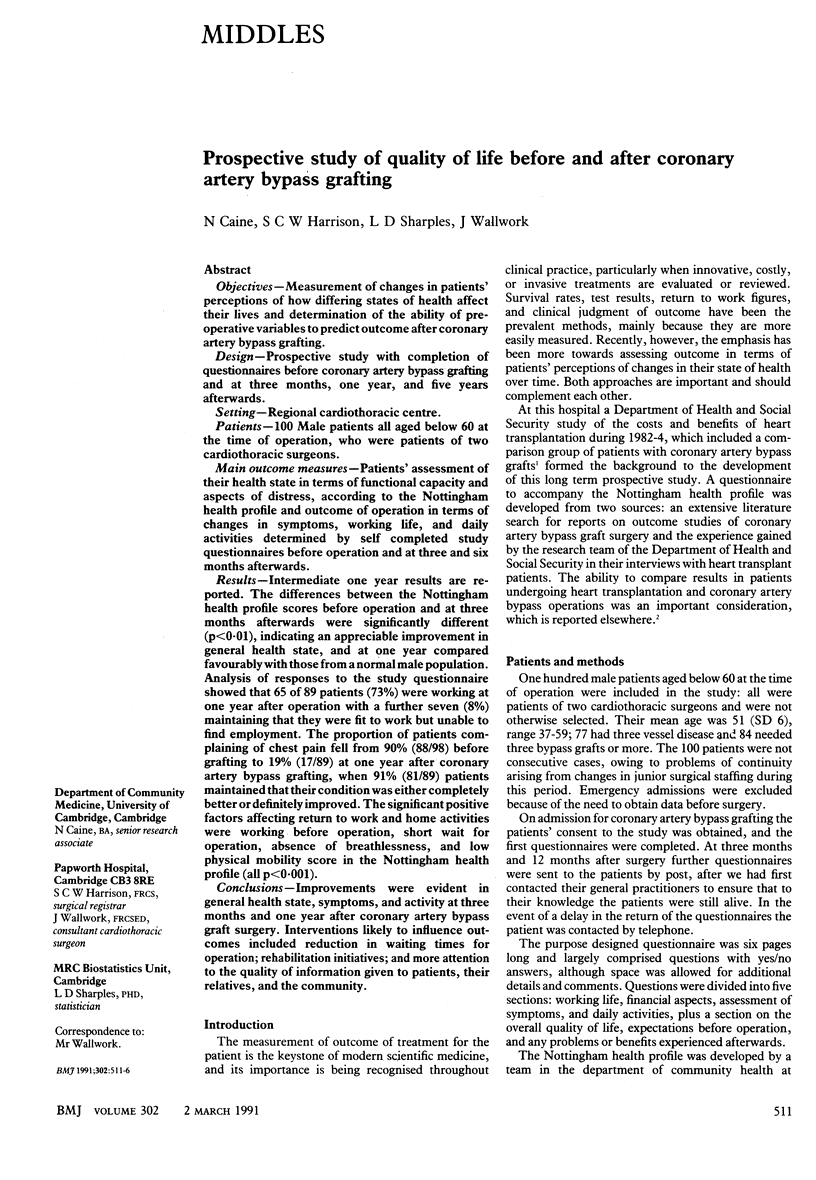Abstract
OBJECTIVES--Measurement of changes in patients' perceptions of how differing states of health affect their lives and determination of the ability of preoperative variables to predict outcome after coronary artery bypass grafting. DESIGN--Prospective study with completion of questionnaires before coronary artery bypass grafting and at three months, one year, and five years afterwards. SETTING--Regional cardiothoracic centre. PATIENTS--100 Male patients all aged below 60 at the time of operation, who were patients of two cardiothoracic surgeons. MAIN OUTCOME MEASURES--Patients' assessment of their health state in terms of functional capacity and aspects of distress, according to the Nottingham health profile and outcome of operation in terms of changes in symptoms, working life, and daily activities determined by self completed study questionnaires before operation and at three and six months afterwards. RESULTS--Intermediate one year results are reported. The differences between the Nottingham health profile scores before operation and at three months afterwards were significantly different (p less than 0.01), indicating an appreciable improvement in general health state, and at one year compared favourably with those from a normal male population. Analysis of responses to the study questionnaire showed that 65 of 89 patients (73%) were working at one year after operation with a further seven (8%) maintaining that they were fit to work but unable to find employment. The proportion of patients complaining of chest pain fell from 90% (88/98) before grafting to 19% (17/89) at one year after coronary artery bypass grafting, when 91% (81/89) patients maintained that their condition was either completely better or definitely improved. The significant positive factors affecting return to work and home activities were working before operation, short wait for operation, absence of breathlessness, and low physical mobility score in the Nottingham health profile (all p less than 0.001). CONCLUSIONS--Improvements were evident in general health state, symptoms, and activity at three months and one year after coronary artery bypass graft surgery. Interventions likely to influence outcomes included reduction in waiting times for operation; rehabilitation initiatives; and more attention to the quality of information given to patients, their relatives, and the community.
Full text
PDF





Selected References
These references are in PubMed. This may not be the complete list of references from this article.
- Cay E. L., Walker D. D. Psychological factors and return to work. Eur Heart J. 1988 Nov;9 (Suppl 50):74–81. doi: 10.1093/eurheartj/9.suppl_l.74. [DOI] [PubMed] [Google Scholar]
- English T. A., Bailey A. R., Dark J. F., Williams W. G. The UK cardiac surgical register, 1977-82. Br Med J (Clin Res Ed) 1984 Nov 3;289(6453):1205–1208. doi: 10.1136/bmj.289.6453.1205. [DOI] [PMC free article] [PubMed] [Google Scholar]
- Gehring J., Koenig W., Rana N. W., Mathes P. The influence of the type of occupation on return to work after myocardial infarction, coronary angioplasty and coronary bypass surgery. Eur Heart J. 1988 Nov;9 (Suppl 50):109–114. doi: 10.1093/eurheartj/9.suppl_l.109. [DOI] [PubMed] [Google Scholar]
- Hunt S. M., McEwen J., McKenna S. P. Measuring health status: a new tool for clinicians and epidemiologists. J R Coll Gen Pract. 1985 Apr;35(273):185–188. [PMC free article] [PubMed] [Google Scholar]
- Hunt S. M., McEwen J., McKenna S. P. Perceived health: age and sex comparisons in a community. J Epidemiol Community Health. 1984 Jun;38(2):156–160. doi: 10.1136/jech.38.2.156. [DOI] [PMC free article] [PubMed] [Google Scholar]
- Jenkins C. D., Stanton B. A., Savageau J. A., Denlinger P., Klein M. D. Coronary artery bypass surgery. Physical, psychological, social, and economic outcomes six months later. JAMA. 1983 Aug 12;250(6):782–788. doi: 10.1001/jama.250.6.782. [DOI] [PubMed] [Google Scholar]
- Laird-Meeter K., Erdman R. A., van Domburg R., Azar A. J., de Feyter P. J., Bos E., Hugenholtz P. G. Probability of a return to work after either coronary balloon dilatation or coronary bypass surgery. Eur Heart J. 1989 Oct;10(10):917–922. doi: 10.1093/oxfordjournals.eurheartj.a059402. [DOI] [PubMed] [Google Scholar]
- Mayou R., Bryant B. Quality of life after coronary artery surgery. Q J Med. 1987 Mar;62(239):239–248. [PubMed] [Google Scholar]
- Monpere C., Francois G., Rondeau du Noyer C., Phan Van J. Return to work after rehabilitation in coronary bypass patients. Role of the occupational medicine specialist during rehabilitation. Eur Heart J. 1988 Nov;9 (Suppl 50):48–53. doi: 10.1093/eurheartj/9.suppl_l.48. [DOI] [PubMed] [Google Scholar]
- Morton J. R., Tolan K. M. Activity level and employment status after coronary bypass surgery. Am J Surg. 1982 Apr;143(4):417–420. doi: 10.1016/0002-9610(82)90189-1. [DOI] [PubMed] [Google Scholar]
- Myers W. O., Davis K., Foster E. D., Maynard C., Kaiser G. C. Surgical survival in the Coronary Artery Surgery Study (CASS) registry. Ann Thorac Surg. 1985 Sep;40(3):245–260. doi: 10.1016/s0003-4975(10)60037-9. [DOI] [PubMed] [Google Scholar]
- Oakley C. M. Is there life after coronary artery surgery? Q J Med. 1987 Mar;62(239):181–182. [PubMed] [Google Scholar]
- Walter P. J. Return to work after coronary artery bypass surgery. Eur Heart J. 1988 Nov;9 (Suppl 50):58–66. doi: 10.1093/eurheartj/9.suppl_l.58. [DOI] [PubMed] [Google Scholar]


